
“Although not the most stylish math program around, with its complete math curriculum, clear tutorials, diagnostic testing, progress tracking and a wealth of online and offline practice questions, CTCMath is a highly effective, flexible and customizable self-paced math program with a price that is hard to beat.”
What We Like
But watch out for…
What is CTCMath
Founded in Australia by Patrick Murray, a former high school teacher with over 30 years of experience, CTCMath is a self-paced online math program for grades K-12.
The program has become increasingly popular with homeschooling parents, as well as those looking to supplement and improve their children’s knowledge and skill in math.
A web browser-based program, CTCMath runs on practically any device with a high speed internet connection, such as a desktop, laptop or iOS/Android mobile device.
What Ages or Grades IS CTCMath Intended For?
CTCMath offers a full math curriculum for K-12 students.
So, in addition to being used as a supplement or enrichment to math learning, it can be used as a standalone learning system for homeschoolers and families learning at home.
Parents should be aware, however, that CTCMath is not aligned to Common Core standards.
Generally speaking, in terms of subject-level coverage, CTCMath is pretty comprehensive, covering:CTCMath is comprehensive in its subject coverage. It covers:
- K-6 math subjects
- Basic Math & Pre-Algebra
- Basic Measurement
- Basic Geometry
- Algebra 1
- Geometry
- Algebra II
- Trigonometry
- Pre-Calculus
- Calculus
The CTC Math curriculum is ordered sequentially, with the curriculum moving naturally from topic to topic, increasing in complexity, as it progresses.
Each main area of math study is referred to as a “stream,” and there are a number of topics within each stream that each have their own lessons.
For example, Pre-Algebra will be broken up into several topics (variables and equations, problem solving, and so on), each of which are themselves made up of several sequential lessons.
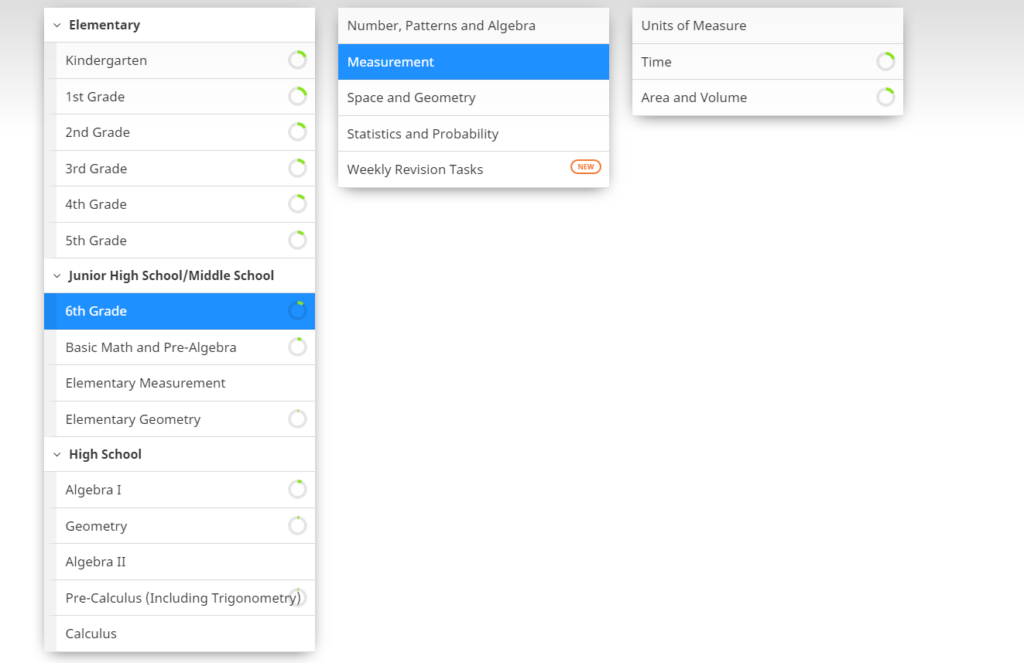
That said, parents have the full ability to pick and choose lessons, or even move up and down grade levels, in order to configure the learning around their student’s needs.
This allows them to really configure the learning around their student’s actual needs and abilities, rather than grade level standards.
Due to this ability to select lessons regardless of grade level, we feel that CTC Math can really be a good resource for students learning outside of a typical grade progression, such as by more advanced students and those who need a bit of remedial help.
Interestingly, despite being founded in Australia, CTC Math does adapt itself well to a variety of countries, making it quite friendly to users around the world.

There is, for example, a United States curriculum you can choose. This adjusts some of the content, such as grade level structure and even mathematical units and measurements, to a format more suitable to US learning standards (inches, yards, dollars, pounds and so on).
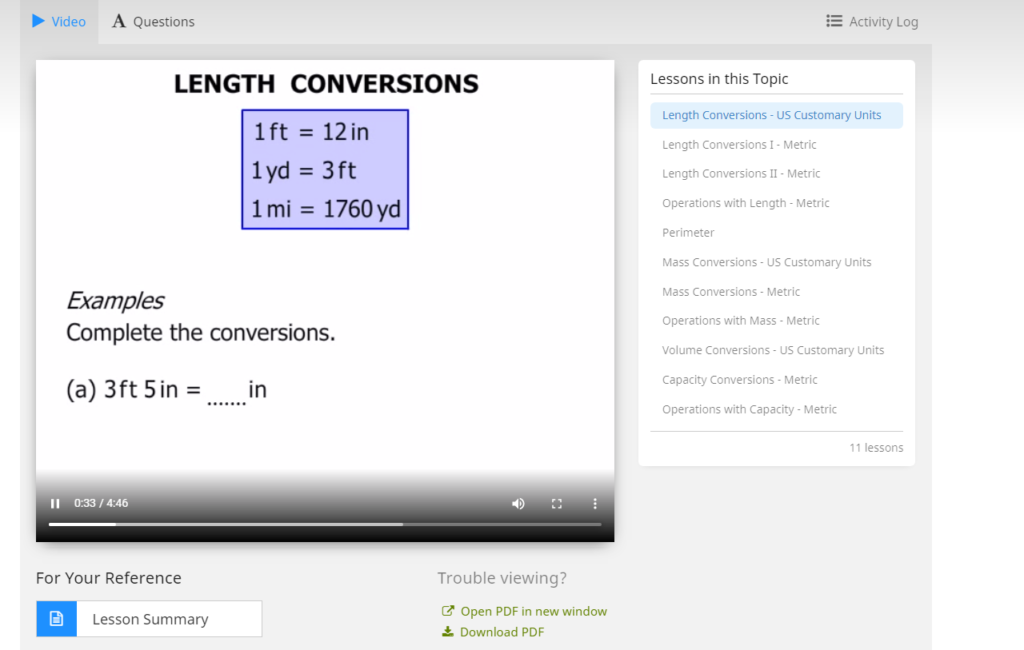
CTC Math Look and Feel
CTC Math has an extremely clean look and feel to it.
In general, features and tools are clearly marked, its interface uses a good deal of white space between objects and there isn’t a lot of unnecessary clutter or distracting elements on the page.
Further, the site’s navigation is pretty simple, which makes it pretty easy and quick for users to find what they are looking for, and the site uses a good deal of unique icons to convey information, whether that is with little circular progress icons for lessons and topics or universal icons for different website pages.
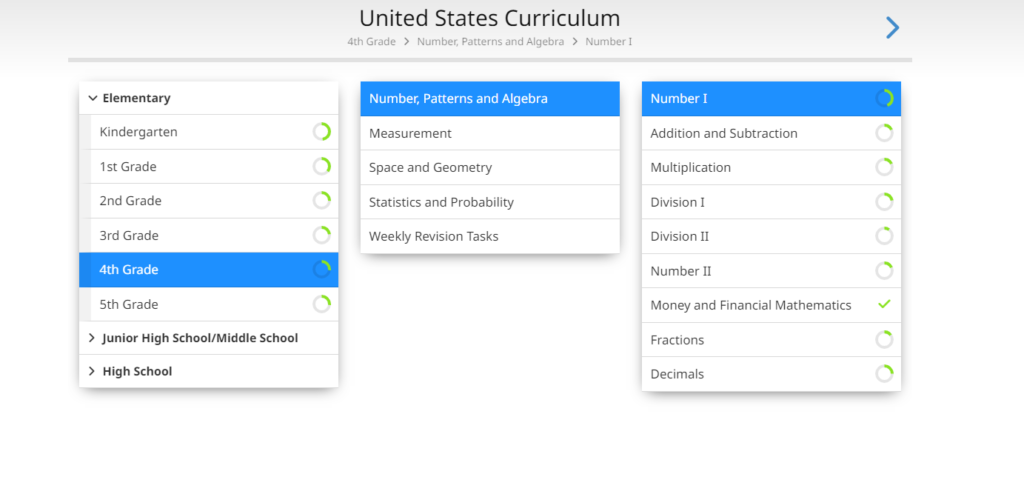
As a result, we feel that CTC Math is pretty user-friendly and there really isn’t a lot that will confuse or distract students as they study.
This simplicity of design also extends to CTC’s lesson screen, which largely consists of a large central video display area, a quasi table of contents and some pertinent links to questions, lesson summaries and so on.
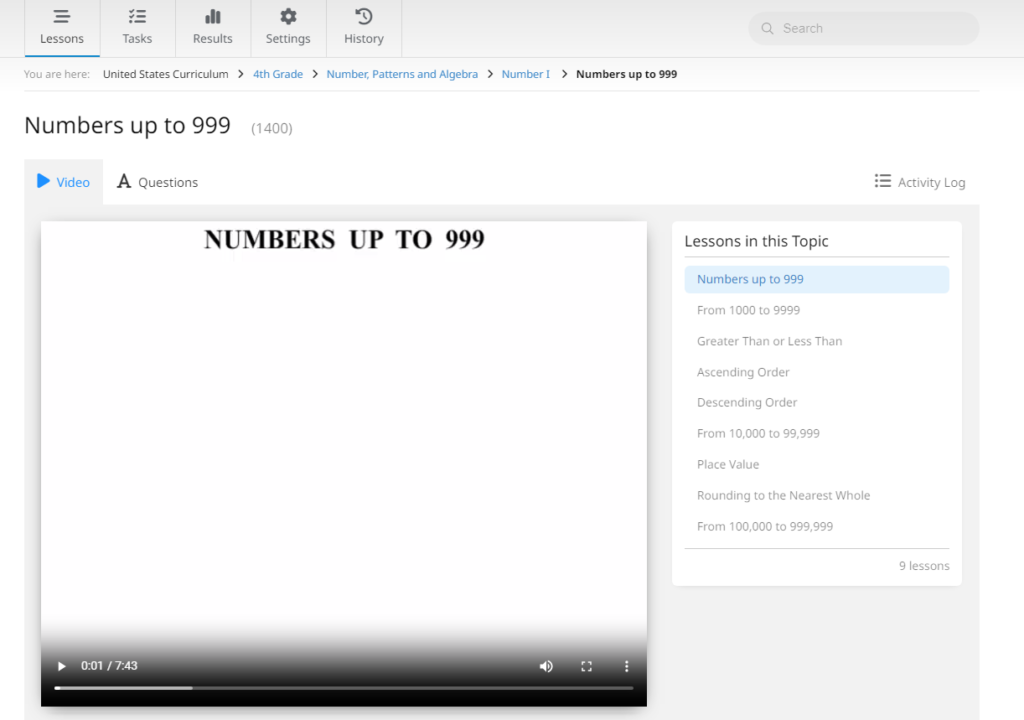
This design seems ideally designed for keeping students’ attention focused on the videos and lesson resources, rather than on any interesting and colorful elements or animations that might attract their eye.
All of this is in line with the program’s self-study approach as, although younger students (especially early/pre-readers) may likely need some help from parents, students should be able to move around the site and access their lessons and work on their own without much trouble.
The only real downside to this simple and clean design is that, although easy to use and not that distracting, it may not be the most visually stimulating or attractive to look at for long periods of time.
This is especially true when it comes to younger students who may prefer to spend their time looking at fun animations, cartoons and colorful backgrounds.
CTC Math Approach To Teaching Math
Video-based, Self-Study Instruction
CTC Math is designed to allow students to learn and practice math on their own with less direct parental supervision and oversight than a typical homeschool math curriculum.
To do so, the program uses relatively short video lessons to explain concepts and work through math problems.
These videos are directed towards the student and generally tend to explain things pretty clearly, using lots of visual demonstrations and tend to introduce/discuss concepts in plain English and in a way kids will understand.
The program also works to guide students through their lessons, providing them with review/practice questions and diagnostic work as the lesson develops, so there’s not a lot of need for students and parents to go searching for materials.
Student behavior and performance, meanwhile, is automatically tracked through the site’s tracking tools, providing parents with detailed information about student performance, site usage, concept mastery and so on.
The program will even send out weekly progress reports to parents should they wish.
All of this allows most parents to step into more of an oversight role (parents of students in kindergarten to grade 2 may still need to be present to help students use the computer and read through things), with parents really only having to set up assignments and learning goals, as well as having to periodically monitor student progress.
This means that CTC Math can be very helpful to busier homeschools whose parents may not have the time to sit down and teach math lessons themselves.
It can also be very helpful to new homeschools and parents uncertain of their own math skills, as most of the teaching is done by a professional, and can be very useful for families looking to help students develop stronger self-guided learning skills.
Procedural
Although it does spend a good deal of time explaining math consents, for the most part we found that CTC Math tends to lean more towards teaching using a traditional, procedural math approach, somewhat similar to other high quality math programs such as Saxon Math, Teaching Textbooks and others.
In other words, the program tends to spend a good deal of time teaching students how to solve math programs quickly and accurately using specific formulas, equations and procedures.
Its lessons often include a good deal of practical and straightforward math exercises and there is a good deal of emphasis on repetition and practice (through in lesson questions, weekly revision exercises, printable worksheets and more) as well as honing students’ math fact and mental math fluency through its games and dedicated exercises.
This is in contrast to more conceptual programs, such as Math In Focus or Singapore Math, which tend to spend a bit more time exploring of the why of math concepts (why things are done the way they are).
Such programs typically feature less direct practice and review and tend to have a bit more of an emphasis on honing general critical reasoning skills, as well as using multiple strategies to solve problems.
Is CTCMath spiral or mastery method?
CTC uses the Mastery method or mastery approach to teaching math. This is an approach to teaching math that dives into material at more depth, presenting one concept at a time until the student attains a certain level of understanding and skill.
This method is opposed to the spiral method, which has topics repeat from level to level (in increasing amounts of depth), letting mastery develop incrementally and over time.
While perhaps not as good at letting kids focus on the whole picture, how the different topics of math fit together for example, the mastery method allows kids to more effectively learn concepts at their own pace, spending time understanding and really working on the material and thereby building skill and demonstrating proficiency.
The mastery method is quite well regarded and has been repeatedly shown to have a significantly positive impact on student achievement.
How it works
Diagnostic pre-testing
Before beginning CTCMath gives parents the option to run diagnostic math tests.
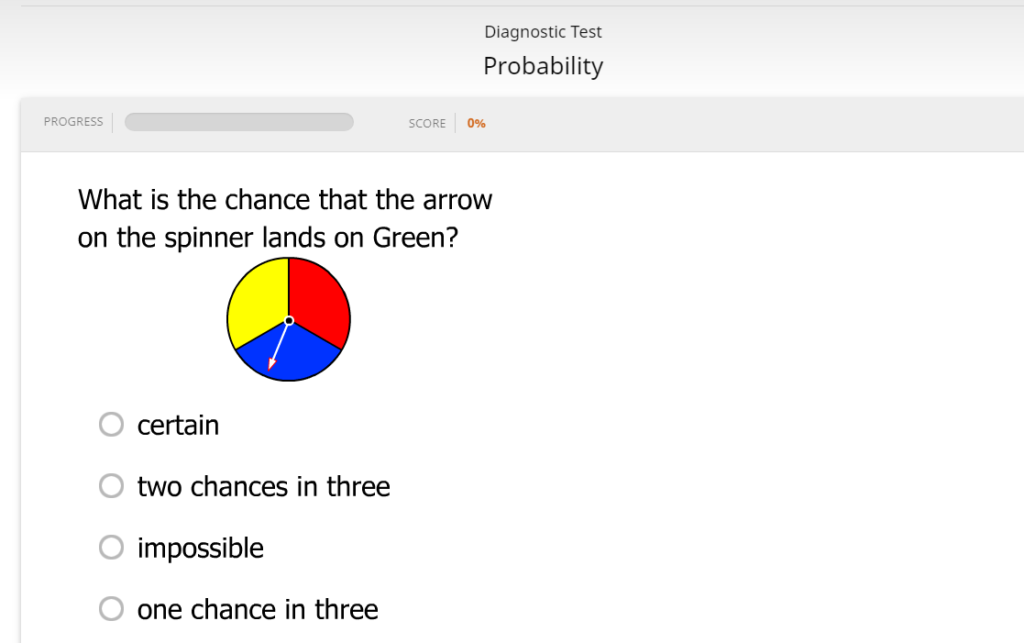
These will generate reports on the existence of any skill or knowledge gaps or deficits that the student may have, which allows parents to then find and run lessons tailored to the child’s specific needs.
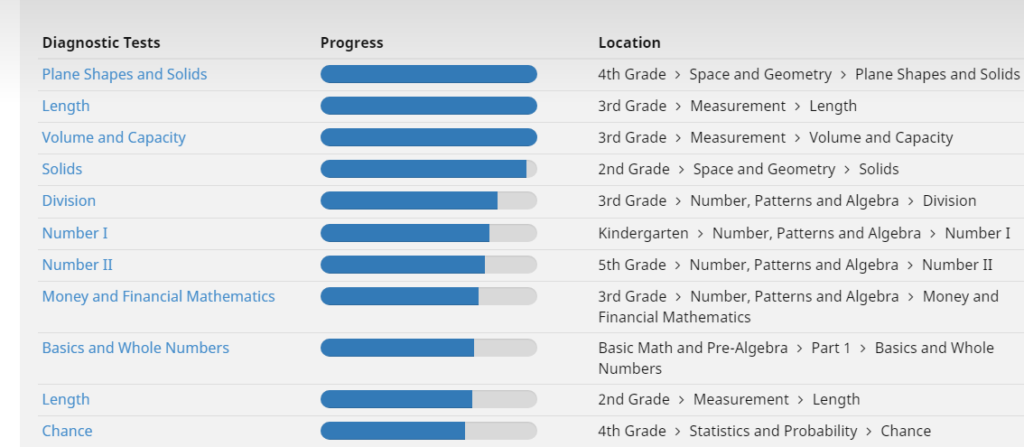
Perhaps recognizing that some students have a harder time sitting through these tests, CTCMath helpfully gives parents the choice of selecting shorter or longer (more comprehensive) diagnostic tests for each concept.

Ultimately, this allows parents to create a far more personalized and targeted learning experience than some other programs on the market, helping students focus on where they most need improvement and is an excellent tool if you’re using the program as a learning supplement.
These tests are optional and parents can always select to simply begin at the students grade level and work sequentially from there.
Interestingly, diagnostic tests can also be accessed and used after lessons to better track student progress.
Method of Instruction
The actual lessons in CTC Math are pretty straightforward and have essentially the same basic format: Video, Interactive Questions, Worksheets, an optional diagnostic quiz/test that can be set up to measure retention and then a report.
Videos
Lessons begin with a tutorial or instructional video. These generally present and explain the concept(s) that will be covered in the lesson and are narrated by Patrick Murray, the founder of CTCMath himself.
A sample tutorial can be seen below, which can give parents a feel for how concepts are taught.
The tutorials are kept short, usually less than 10 minutes long, which we find is generally helpful in preventing kids from becoming bored and zoning out.
This also tends to “chunk” the material, breaking complex topics into smaller, more easily understood segments, a tactic that helps prevent students from feeling overwhelmed and frustrated.
While the lessons are not as animated and flashy as some other programs out there, they are clear and well organized with short animations, notations and occasionally graphics to illustrate various concepts and teaching points.

Perhaps due to the lack of flashiness, kids aren’t as likely to be distracted by the look and feel and can focus more on the content, although we’d recommend a little more parental supervision for the youngest kids (K-2) since it may not intrinsically interest them as much.
As a bonus, we found the narrator’s Australian accent to be rather charming and fun to listen to, although some kids in the US, particularly younger ones, may not have much experience with Australian-accented English and may need a few minutes to get used to it.
Helpfully, tutorials can also be printed out as one page summaries, which is great for kids who have a harder time following audio/video instruction, prefer to read things through or just need to take things more slowly.
Interactive Questions
Following the video, students answer a series of questions on the material. They can do so through the program itself, where they input their answer into the screen either as a number or a letter in the case of multiple choice answers (which students sort of drag to the appropriate location).
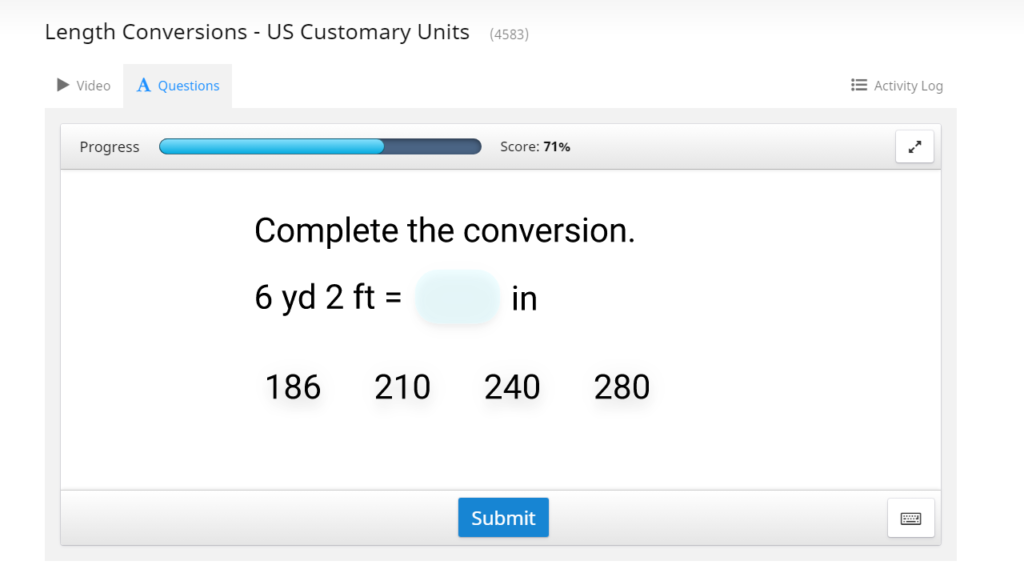
Feedback is given in the form of a score on the progress bar at the top of the screen. Starting at 0, the score rises or lowers with each question they get right or wrong, giving kids real time feedback and an easily understood measure of their mastery.
Answers are given at the end, once all questions have been submitted, which is good as it gives kids an idea of where they went wrong if they made any mistakes, yet prevents them from “peeking” at the answers as they go along.
As this is a mastery method of teaching, in order to progress students have to reach a certain score to progress to the next lesson, which is set by parents ahead of time. Of course, if there is an issue, kids can always go back and rewatch the tutorials as often as they need.
Parents should note that there is no digital area for showing work so kids will likely need to use paper as well to derive the answers.
Worksheets
In addition to practice problems, CTCMath also offers worksheets for each lesson, which come as in-program PDFs that can be printed out and worked on offline.

In general, students work these out on their own using scrap paper and then input the results as multiple choice.

There is the option to do the questions manually, in the form of a printable PDF worksheets, a feature we liked quite a lot.
We feel this can become a better choice with more advanced topics and grades, as it emulates the pencil and paper structure they may see in school or on standardized tests, it lets them practice showing their work for more complex answers, and it gives parents the option of taking work offline and away from the screen.
Weekly Revision Tasks
For Grades 1-6 there are also weekly revision tasks, which are little assignments or homework that kids can be assigned.
These let kids get more practice on the skills they’re developing. There are a mix of questions from across each section, mixing and testing various concepts to give kids a pretty thorough review of the material.
These revisions are available online or as a printable PDF (the answers of which can then be inputted into the program to keep track and be scored).
We prefer them as printables ourselves, as (like the worksheets) they are a good way to give kids practical experience working through math problems with pencil and paper instead of working through an app.
Parental Controls
Clean, easy to use and very straightforward, the CTCMath dashboard gives parents the ability to manage all of their students accounts from one convenient location.
In fact, unlike many other programs out there, CTCMath has built-in and quite capable lesson planning and tracking capabilities, which can be of particular interest to homeschooling parents.
It lets parents add and manage tasks for their students, assigning lessons, worksheets, question banks and other tasks as needed.

CTCMath also offers parents the ability to easily and efficiently keep track of student activity and progress with student reports.

These help parents track important information about how their child is doing, such as lessons completed, scores, how many attempts they took, their assignment completion, right down to the level of individual questions that the kids are doing.

In this way, CTCMath’s progress tracking can yield potentially important insights into the math skills and knowledge of the child, and can really help parents adjust their child’s learning material to their needs more effectively.
Finally, from the dashboard parents have quite a few ways to personalize learning around the needs of their individual children, making CTCMath one of the more flexible math programs out there for parents.
Parents can select individual lessons from the entire K-12 curriculum, have students start at their grade level or use the diagnostic testing to attempt to identify the appropriate level in which to start.
CTCMath also allows parents to customize goals, for example by setting number of lessons and topics to cover each week and what passing grade the child needs to progress in their lessons.
Question Bank Wizard
Taking customized practice to the next level, CTCMath offers a Question Bank Wizard that parents can access through the dashboard.

Leveraging the program’s rather massive database of math questions, the wizard lets parents easily build their own, custom worksheets for targeted practice and then set them as a task to be completed.
The Question Bank Wizard is highly configurable. Parents can set:
- The math topics to be included
- How many of each topic to include
- The number of questions
- A time limit
- The relative difficulty level of questions
- And more
The Wizard even allows parents to get down to the individual question level, allowing them to open individual worksheets to delete particular questions or move them around.
Because the customization drills down to the individual question level, we feel that it allows parents to really get a good sense of what types of questions are giving kids problems and give them more specific practice.
Math Fact Practice Games
In addition to its lesson materials and resources, CTC Math has recently added a couple online, skill-testing games designed to help students work on their math fact fluency – Speed Skills and Times Table Shoot ‘Em Up.
Speed Skills
Speed Skills is pretty much an online flashcard like game (not too unlike XtraMath and some others that we’ve looked at).
Divided into four levels, the game tests students’ ability to solve addition, subtraction, multiplication and division (with and without remainder) skills by having them input the answer to various computational problems drawn from a bank of questions as fast and as accurately as they can.
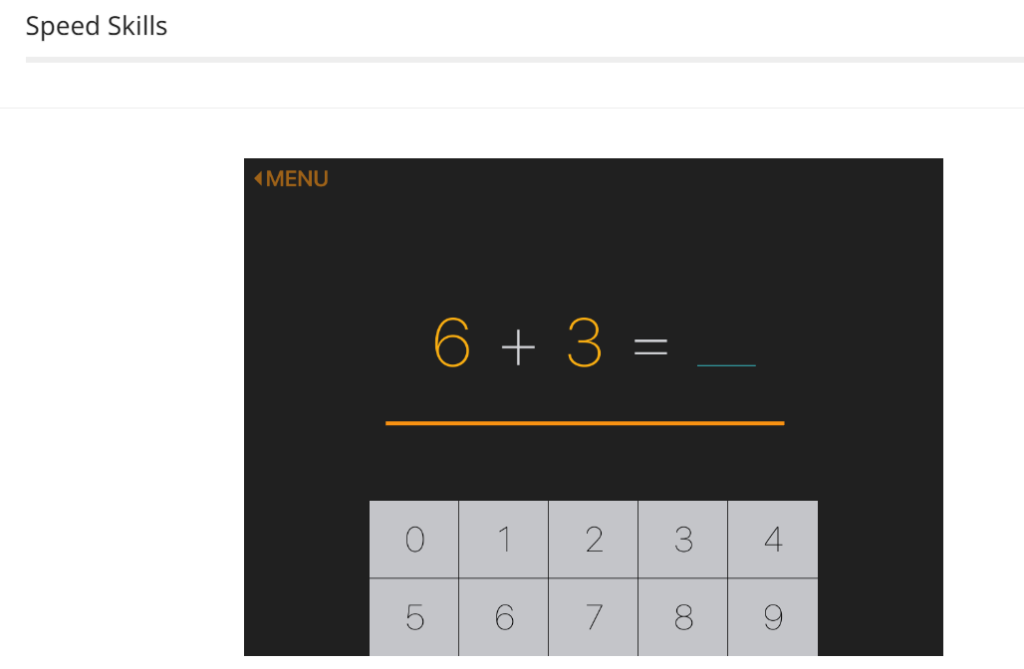
Although not quite as high tech or dynamic as an online game (it is essentially just numbers and equations on a plain background), this form of practice is a pretty well recognized way of helping students rapidly hone their operations skills and, being pretty visually simple, can help them stay focused while they work.
Practice is also pretty quick.
With most sessions only taking a few minutes to go through, playing Speed Skills shouldn’t be too intimidating or frustrating to go through, even for students who really don’t like traditional flashcard-style drills.
Times Tables Shoot ‘Em Up
CTCMath has also added a built-in to help students work on their mental math as it pertains to the times tables – Times Tables Shoot ‘Em Up.
Somewhat similar to Space Invaders, the game has students pilot a rocket ship with rows of numbers descending towards them.
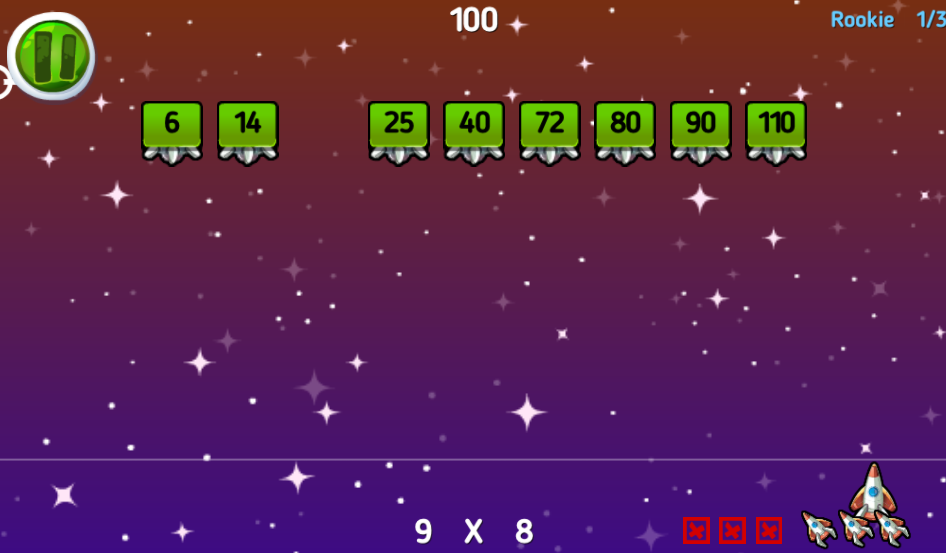
Students are given a multiplication question and must fire at the correct response before the numbers hit the bottom of the screen.
If they can clear a few screens quickly, students can be rewarded with free play where they can start blasting at incoming enemies (who can actually fire back at the player).
Unlike Speed Skills, Times Tables Shoot ‘Em Up is an online educational video game of sorts.
It uses fairly modern, mobile game-style graphics, fun music, high scores, power ups and more to better mask the multiplication drill that students will be doing.
Overall, we found CTC’s inclusion of two different methods of mental math/math fact practice to be kind of interesting.
Not every family is a fan of game-based learning in the style of Times Table Shoot ‘Em Up, even if it is quite well done and quite engaging, and by including a more traditional, focused practice activity, the program can provide more broadly appealing practice.
The only real downside is that, as of writing, there is really only the option to practice multiplication tables.
As a result, fans of game-based math practice really don’t have many interactive and fun options when it comes to addition, subtraction and division.
Pros and Cons
Pros
Video-based, multisensory learning
The core of CTC Math’s lessons is its short math instructional videos, which explain math concepts in a clear manner, often with a variety of visuals, props and on-screen demonstrations.
Combined with its printable worksheets and in-lesson activities and exercises, the program can make math learning quite multisensory and effective for different learning styles.
Easy to individualize and customize
With its diagnostics, custom question banks and ability to draw upon lessons and topics from the entire K-12 range, CTC Math can more easily be configured and personalized to a student’s needs and skill level compared to other options.
Printable resources allow for offline learning
In addition to its video-based learning and digital exercises, CTC Math also offers parents and students printable worksheets and exercises that allows them to take learning offline and away from a screen.
Fun and effective mental math and math facts games
Aside from its lessons, CTC Math has also integrated a couple digital game resources, Times Tables Shoot ‘Em Up and Speed Skills, that can help students get the practice and drill they need in mental math and math facts but in a more engaging and interesting way.
Detailed progress tracking and diagnostics lets parents keep an eye on student skill development
Parents can easily keep abreast of their child’s performance in CTC (and even get some much needed insight into their skill and knowledge level) through the program’s fairly detailed and thorough progress tracking and analytics, as well as through optional weekly email reports.
Family membership provides good value for larger families
Unlike many other online math programs out there CTC Math offers discounted pricing for larger families, something that many homeschooling families will appreciate.
Cons
Not quite as visually stunning as some other programs
Although its clean looks can help keep kids focused on its learning, CTC Math may not be the most visually interesting resource for some kids to use, which can hamper their interest in it somewhat.
Australian-accented English can take some time for young kids to adjust to
Although the video lessons are quite clear and make math concepts quite easy to understand, and while it has been adapted to US curricula and standards for measurement, the program and its founder are located in Australia and the accent, while certainly charming, may be a bit challenging for some younger students to understand at first.
Who Is CTCMath Ideal For?
New homeschooling parents and those uncertain about teaching math themselves
CTC Math is a pretty comprehensive and effective self-study online math program in our opinion.
Its videos and guided lesson practice can carry students easily through their lessons with a minimum of parental oversight, which in turn can make it a highly useful program for parents who are new to teaching, as well as those whose own math skills might be a bit rusty.
Busy homeschools looking for more of a self-study option for math
Not every parent necessarily has the time to sit down and teach math to their child and CTC Math, with its comprehensive videos, lessons, assessments and progress tracking, can take a good deal of the burden of teaching off and allow them to concentrate on other tasks.
Students who enjoy multisensory, video-based instruction
While some students do fine with textbook learning, others may require something a bit more dynamic and visual to help them understand math.
With its clear and highly visual video lessons, CTC Math can be a great option for the latter.
Students who would like to explore concepts from different grade levels
CTC Math can be a great option for advanced and remedial students alike as it allows families to pick and study math topics from across the K-12 grade level, meaning that students can readily explore more complex topics or brush up on the basics.
Who Is It Not Ideal For?
Homeschools looking to reduce screen time
Although its video lessons are comparatively short, and while the program does offer offline exercises and practice activities, CTC Math will still add a fair amount of screen time to a student’s week, something that some families may have an issue with.
Families looking for more hands-on math
CTC Math’s primary method of instruction is through video and reading/writing-based practice exercises and there really isn’t much in the way of kinesthetic or hands-on math learning.
Homeschools on a strict budget
At nearly $200 per year (just under $30/month), while CTC Math is certainly not all that expensive, it can still sometimes be a bit challenging to squeeze into very strict budgets.
How Much Does CTCMath Cost?
Note: Prices correct as of writing.
CTCMath is a subscription based online math program. It essentially offers two plans that you can get as either a month-to-month or yearly package.
There is a single membership, which gives one student access to the program and a family membership, which gives multiple children access under their own, individual accounts.
CTC Single Membership
| Monthly | Yearly |
| $29.97 | $197 |
CTC Family Membership
| Monthly | Yearly |
| $39.97 | $297 |
CTCMath subscriptions give access to all courses, grades and levels within the program.
In other words, parents aren’t tied to one grade but can explore topics at all grade levels, which gives parents more flexibility in terms of what their children can be working on and greater ability to customize learning to the child.
At $197 for a year’s course, CTCMath is more expensive than buying complete yearly sets from some more traditional math curricula providers, like Saxon or Singapore, although not by a huge amount, especially when you consider that the CTCMath digital package is all inclusive and doesn’t require shipping and handling.
This pricing model is quite handy and cost effective for larger families with children of different age ranges, or for those with students who might be a bit more advanced or need revision of certain concepts
You can also try CTCMath for free for 30 days
The company does occasionally run discounts and specials, so make sure you check out their current pricing.
Is CTCMath worth the money?
In short, yes.
While CTCMath is not the most affordably priced self-paced math curriculum out there, it does deliver a lot of value for your money.
For one subscription price, parents and students get full and unrestricted access to a complete K-12 math curriculum with clear video tutorials, interactive math questions, worksheets, diagnostic tests and progress tracking.
The program is a particularly good deal for families with multiple children of different age ranges as, for a comparatively small amount more per month, they can add as many child accounts as they’d like and use the K-12 curriculum as needed.
The curriculum, although not common core aligned, is quite comprehensive in scope and is based on a math teaching approach, the mastery method, that adds quite a bit of depth and is also a highly regarded approach to teaching.
CTCMath provides a lot of educational content as well, with hundreds of lessons and thousands of questions on hand, as well as the ability to create your own custom worksheets with the highly customizable Question Bank Wizard and the near endless combinations of topics and questions that are possible.
We particularly appreciate that the program offers a great deal of printable practice material, not only giving kids the option of practicing working with pencil and paper but also letting parents opt to take learning offline and away from the screen.
Finally, CTCMath does an excellent job at helping parents create an individualized math program for their children. Diagnostic tests can help identify skill and knowledge gaps, while parents can take near complete control over the lesson order, structures, goals and assignments for their children.
With the Question Bank Wizard, this level of personalization and customization even extends right down to the individual question level, should parents so choose.
Bottom Line:
Although it’s not the most stylish math program around, with its complete math curriculum, clear tutorials, diagnostic testing, progress tracking and a wealth of online and offline practice questions, CTCMath is a highly effective, flexible and customizable self-paced math program with a price that is hard to beat.
FAQ

About the Author
David Belenky is a freelance writer, former science and math tutor and a tech enthusiast. When he’s not writing about educational tech, he likes to chill out with his family and dog at home.
